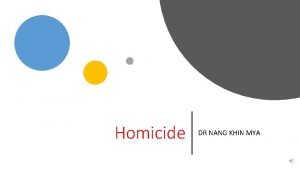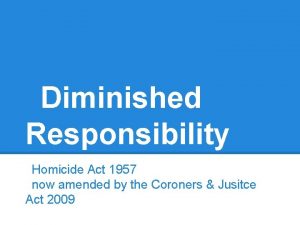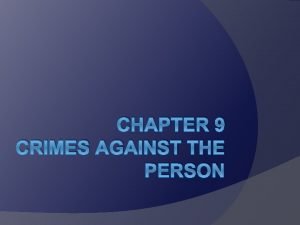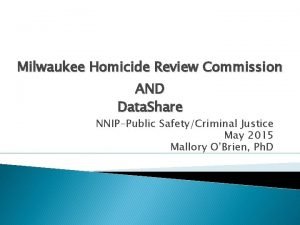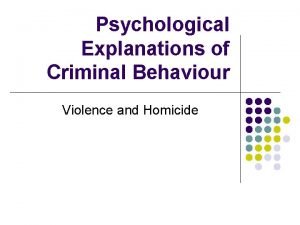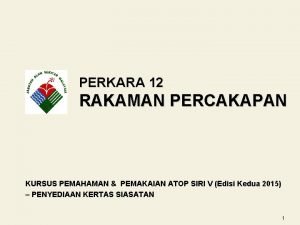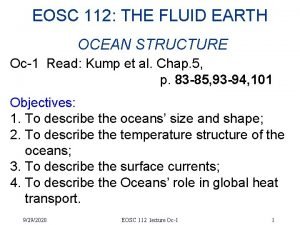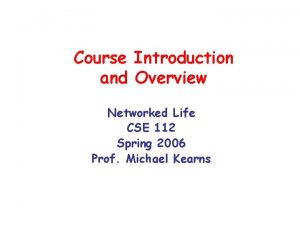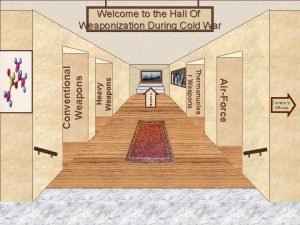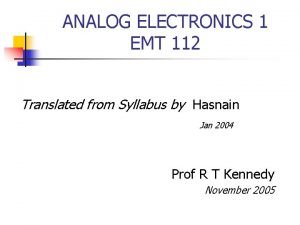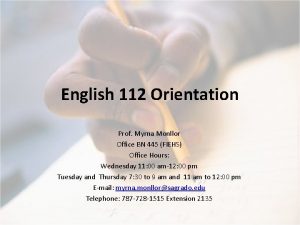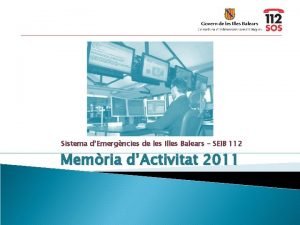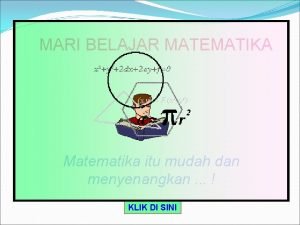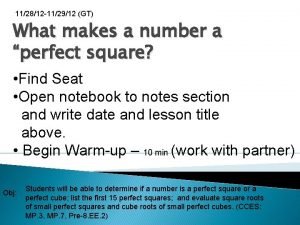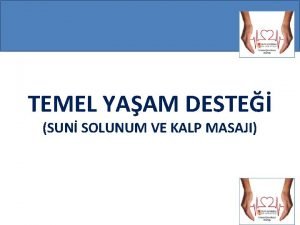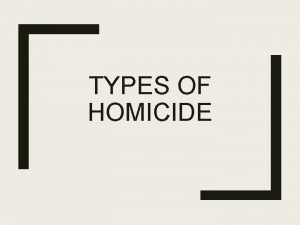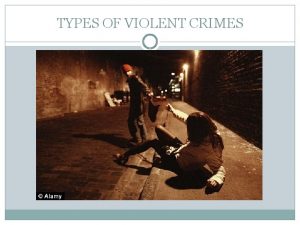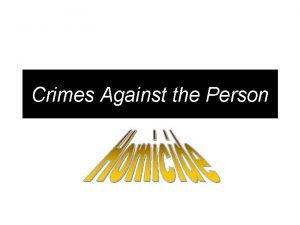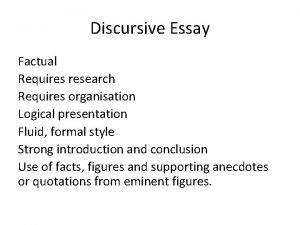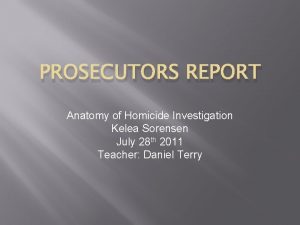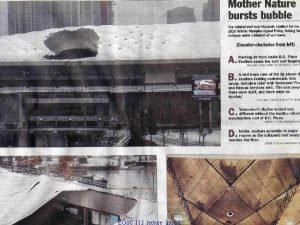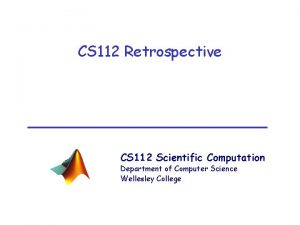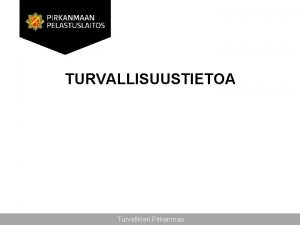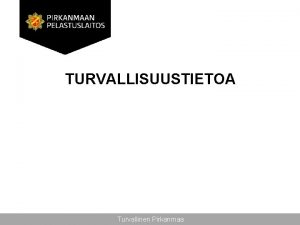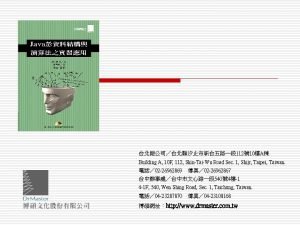Homicide Investigation JS 112 051710 Homicide Investigation Requires













































- Slides: 45

Homicide Investigation JS 112 051710

Homicide Investigation • Requires the greatest effort of all major crimes • Coordinate witnesses, suspect, officers, forensic pathologist, criminalists, medical examiner etc. • Many disciplines, attention to detail • Brings together many concepts of the course

Initial Steps • • Initial focus: Finding the body Rules of first officer on the scene still apply. Find and collect all evidence Determination of suspicious death vs. natural causes vs. accident or suicide

Murder, Suicide or Accident? • Suspect the worst- Murder • Murderers have been known to make the death appear to be an accident or suicide • Systematic and accurate investigation can reveal the deception • Evaluate the circumstances revealed at the crime scene • Questions: – What was the cause of death? – Could the deceased have produced the injuries or brought about the circumstances that caused the death? – Are there any signs of a struggle? – Where is the weapon, instrument or object that caused the injuries or traces of the medium that caused death?

Cause of Death • The injury, disease, or combination of the two which initiated the fatal train of physiologic disturbances. – Multiple Blunt Force Injuries – Chronic Obstructive Pulmonary Disease – Drowning – Undetermined

Manner of Death • The fashion in which the cause of death arose. – Natural – Accident – Homicide – Suicide – Undetermined

Reasons For Determining Cause and Manner • Innocent exonerated. • Murder recognized. • Compile medical evidence for civil/criminal matters. – Wrongful death suits. – Suicide exclusion clauses. • Recognition of hazards to public health.

Cause of Death • Apparent cause of death vs Actual cause that will be determined by the medical examiner • Determining the cause of death represents a starting point and assists in putting facts and circumstances behind the death into focus. • Investigator should have a working knowledge of appearance of injuries and wounds in order to take first steps in death investigation • Erroneous estimate of the cause may lead the investigation in a wrong direction and may even jeopardize the ultimate solution of the crime • Experience vs Expertise • Cooperation and teamwork with investigator and ME

Suicide • Self inflicted injuries or could have deceased brought about the circumstances that caused the death? • Answer based on the evaluation of injuries and other factors about the mental and emotional state Common modes of death by suicide are drowning, hanging, shooting, poisoning, jumping from heights, cutting arteries, stabbing and strangulation. • Detailed examination of the crime scene to determine if factors are consistent with suicide • Think about the 55 gallon gal suicide shown by Wiley…

Suicide (continued) • Possible suicide Nature and position of injuries Hesitation marks involving wrist slashing Gunpowder tattooing firing at close range Wound location within reach of the deceased In suicides with guns the victim usually drops the weapon or throws it up to several feet away – No blood on the inside of hands or corresponding parts of the gun grip and the rest of the hand blood soaked is usually a good indication that the victim fired the shot – Dead in a room with door locked from the inside- look for unusual traces and marks on doors, locks and latches – – – • Suspicious death – Defense injuries would not be expected on a suspected suicide – Blood marks on the hand grip that do not match

Suicide (continued) • Interviews with the deceased’s relative and friends • Information from physician or psychologist • History of suicide threats or suicidal tendencies significant • Search for suicide notes (55 gallon gal) at the victim’s residence and workplace • Have a qualified document examiner evaluate the note for authenticity. Collect handwriting exemplars and search for the writing instrument and paper used. The document should be examined for latent prints.

Suicide (continued) • Motives. Terminal illness Poor financial situation Marital or family problems Psychological problems- Often killing family members precedes the suicide- Then it becomes a homicide investigation – Inheritance and insurance matters will be influenced by the order in which the victims died – Sometimes motives are not apparent. So deeply hidden they may remain a mystery. – –

Struggle? • Obvious signs of struggle – Bloodstains- considered the best clues for the reconstruction of the course of events – Pulled-out hair – Overturned or displaced articles of furniture – Rumpled rugs – Marks of weapons – Injuries

Struggle Bloodstains • • • No bloodstains produced in first stage of attack If victims do not immediately become unconscious at the first blow, stab cut or shot it can nearly always be assumed their hands will become covered with their blood from touching the injured parts of their body If they attempt to escape or resist, their blood covered hands leave marks often indicating their position. After a struggle in a room with furniture a large number of marks of bloodstained hands may be found on the legs of tables and chairs. Bloody hair leaves stains on undersides of tables and chairs Bloody imprints on doors, phones, hung up clothers, draperies, curtains etc. Blood spatter on the door- need to note position of the door. Drops of spattered blood can indicate position of a piece of furniture Especially important are footprints in blood (remember the first cold hit case)

Other signs of struggle • Pulled out hair- certain indication of struggle • Overturned and displaced furniture • Chairs, pedestals and other light pieces of furniture fall in the direction in which the struggling persons are moving. • If you suspect a criminal has righted overturned furniture, examine it for fingerprints • Prints on light furniture, its position should be examined as it may indicate the furniture was used as a weapon. • Heavy furniture displaced – marks or scraping indicate displacement. • Rumpled rugs provide signs of struggle. • Murder victim may kick floor or furniture and shoes leave marks etc.

Other signs of struggle • Marks of weapons – e. g. ax swung and scrapes a ceiling or slips along a piece of furniture – If bloodstained then the blood will be left in the shape of the weapon – Cartridges, cartridge cases, bullets and bullet holes are obvious indications of weapons • Defense injuries – Marks appear to be of a struggle

Death by violence outdoors • Not so distinct as indoors • Fight preceded, ground will be trampled • Footmarks made with shoes of different sizes and appearances or if marks have the form that results from feet set down obliquely against the ground indicate evidence of a fight • Suicides with hanging, ground may be trampled but marks have normal appearance of those of a person walking. • Struggle outdoors: bloodstains, pulled out hair, marks of weapons, resistance injuries, broken twigs, trampled leaves, torn-up moss and grass, and footprints where you normally avoid

Location of Weapon • Absence of a weapon at the scene indicates murder • If a weapon or instrument is found then an analysis of the situation should be done to provide a preliminary decision as to whether it is murder or suicide • Nothing should be moved or altered • If evidence might be destroyed, the investigation needs to be postponed • If found, then photograph and describe position • Pathologist should always be consulted to determine if an object can be considered a dangerous weapon

Examination of a dead body at the crime scene • Before examining the body- Precautions • Example of officer probed wound with a pencil to determine track of a bullet! • Clothing of victim examined but only visible parts before pathologist arrives • Buttoned, attached, creased, wrinkled, marked by injuries, stains, position of clothing, how far pants pulled up, garments twisted, inside out. • Any displacement from normal should be measured. Shirts checked for button side right to left or left to right

Clothing • Check folds. Horizontal or vertical. Due to crumpling of garment • When body is dragged, horizontal creases occur that are dirty on the outside but clean on the inside folds • If a body is lifted, characteristic formations are produced. • If the raised part of a fold is bloodstained but the inner part is free from blood, then the position of a part of the body when violence was exerted can be determined with certainty • Damage to the clothes from tearing, crushing, cutting, penetration should be measured and documented. At autopsy, the damage to the clothes and position of wounds on the body can be compared. Important information on the body position when the injury was inflicted.

Stains • Stains may consist of blood, semen, saliva, phlegm, vomit, feces, urine, dust, dirt or other contamination. • Document, type, location, size, flow. • Direction of flow especially strems of blood can contribute to the reconstruction of events in death by violence. All marks of blood flowing “in the wrong direction” should be examined and photographed • Blood froth when a person continues to breathe after blood has penetrated the air passage coming out of the mouth and nasal passages • Estimate blood amount

Homicide Investigation. Step-by-step • 1) Confirm the appearance of signs of certain death • 2) Photograph the body before altered. If already altered, photograph then return to original position and photograph • 3) Preliminary investigation of pockets- ID documents in wallet, purse, watch or other valuable articles. Very carefully so original position of clothes restored. • 4) Preliminary sketch of the body position. Marks made at places on the floor, top point of the head, ears, elbows, hands, crotch, knees, heels and point of toes. Outer contour with chalk • 5) Position of the body described. In relation to nearest article of furniture, object or fixed point. Visible clothing described without details • 6) Detailed examination. Only visible details are examined and described. The original position of the body must not be changed

• • Homicide Investigation-Step-by-step 7) Head described and examined in relation with respect to the body, eyes and mouth open, color of skin, injuries, presence of blood, state of hair, presence of saliva, phlegm, vomit, foreign bodies (soil, sand, vegetable matter, hair etc) Direction of flow of liquids should be noted 8) Examine the trunk, position, bending or twisting, the position of visible clothing and condition, folds, injuries to the body and clothes, presence of blood, saliva semen phlegm, vomit, and foreign bodies. 9) Arms and legs examined in the same way as the trunk. Hands should be given special attention. Presence of rings, wristwatches, marks left by objects. Foreign objects examined, especially fragments of hair or skin under nails. Dirt from under nails collected. If detailed exam cannot be done then enclose the hands in clean paper bags tied securely at the wrists. Legs, distance between knees and between heels. Soles of feet or shoes for presence of blood and other material 10) Course or sequence of events. Consider opinions of others for reconstruction. 11) Underside of body and those portions covered by clothes should not be examined at the scene unless done in the presence and request of the pathologist. 12) After body removed, area under the body should be examined. Critical evidence may be there. Pool of blood, bullets, fragments of bullets, projectile… Relationship between location of injuries and bloodstains on the floor should be established. 13) Body should be transported in the position found if possible. If necessary, clothing can be fixed in original position with pins. Moved on clean sheet of cotton or plastic or on an undertakers impregnated paper sheet. Protect body from contamination and prevent minute evidence from loss. 14) Officer should accompany body to hospital, morgue or autopsy.

Detailed examination • Photographs • Determine entry and exit paths for coroner and check for evidence • Methodically planned examination with nothing forgotten • Make accurate notes with details. Never throw away notes • As far as possible put back into original position. Use chalk before moving to mark original position. • Measurements, as each object is found. • Shooting, look for weapon, cartridges, cases, bullets. Photograph if found. Fingerprints recorded.

Security concerns Outdoor crime scenes • Difficult to physically secure • Accessible at many points by many people • Perimeter may grow beyond original boundaries • As for other scenes, multiple perimeters with varied levels of security • Access strictly monitored and regulated

Searching an outdoor area • If no emergency exists (eg bad weather, missing child, injured vicitm) time can be taken • Identify resources and human support needed • Consider using volunteers with training or experience (eg fire departments, emergency response personnel, National guard, military) • Instruct search party as to scope and protocols and how to respond if find evidence (Leverite) • Trained CSI leader should form subgroups and be sure single command post gets all info

Support Equipment for Searching an outdoor area • Support equipment – Canines • locate missing individuals, dead and decaying remains and objects touched by those missing • Should be used early as presence of large search parties will interfere with tracking – Helicoptors • Large and/or remote areas • FLIR – forward looking infrared detects thermal patterns for living or decaying bodies in total darkness

Communications for Outdoor scenes • Communications with command center • Different search groups must communicate vital information in timely manner • Large search parties require many portable radios • Cell phones but only in coverage areas (and only with a good carrier!) • If underwater, need trained personnel

More considerations Outdoor crime scenes • Inclement weather – Immediate attention and response to minimize loss or destruction of evidence – Imprint and blood and trace will be damaged – Use tarps to protect – Document, preserve and collect if possible without delay – Winter conditions may require thaw. Portable heaters and tarps can be used to melt ice and snow if needed

More topics on Outdoor Crime Scenes • Highways Secondary scenes, dump sites, primary shooting scene Police involved shooting- high profile Difficult to safely secure with high traffic Broken glass, ejected cartridge cases empty pistol magazines, imprint patterns – Shut down highway if possible. Divert traffic away. Some impossible to close, traffic too great and insufficient alternate routes – – • Hostile crowds – Quick, effective documentation (seems like oxymoron) – Gather evidence transport to more secure location

Processing Outdoor scenes Perimeter established Document before any aspect disturbed Map with reference (base or datum point) Coordinated can be re-established if needed. All evidence taken should include distance and compass directions • Use of GPS with accuracy of a few feet • Need more precise distances with traditional measurements • • •

Necessary equipment specific to outdoor scenes • Pruning shears, axes, saws to clear vegetation • Marking devices or placards mark evidence or areas where + metal detector • String and police line tape- perimeter • Shovels, hand trowels and rakes- removal of dirt in excavation and digging • Paint brushes-careful removal of dirt in contact with buried evidence • Large buckets to remove soil and debris to other areas for further processing • Sifting screens to search for small objects

Necessary equipment specific to outdoor scenes (continued) • Evidence bags and boxes- to store evidence recovered • Portable generators- power for lighting and heating • Tarps and tents- temporary structures to protect scene and evidence • Mapping equipment- GPS, tape measure, ruler, compass and protractor • Metal detector to detect any small metally objects buried • Access to ground penetrating radar • Communication devices

Estimating time of death • Postmortem signs of death – Changes in the eyes- Cornea becomes dull and film may appear over the eye within several minutes to a few hours depending on open or shut, temp, humidity and air current. Not reliable – Temperature of the Body- Rate of cooling depends on factors, temp at time of death, environment temp. clothing, surface area to body weight. Core body temp considered one of the more reliable. Insert thermometer in liver vs ambient temp – Rigidity of the body. Immediately after death, the body is flaccid. Rigor mortis sets in extremities jaw, fingers first and is complete in 2 -6 hours. Remains for 23 days then disappears – Lividity: Blood settles to lowest portion of the body due to gravity. Blue or red marks on skin. First signs in 1 hour, full development 3 -4 hours. Does not form on parts exposed to pressure. Can be used to determine if body was moved. • Decomposition- Autolysis and bacterial action • Action of insects and animals

Other indications of time of death • Stomach contents and intestines • Watches and clocks • Conditions – – – – Papers in mailboxes Food materials state of decomp Dampness of laundry hung up Cobwebs Dates on clendars, Flowers withering Growth of vegetation outdoors

Decay • Extent of decay of clothing – Cotton decomposes 4 -5 years – Wool after 8 -10 year – Leather and silk only after 20 years or longer

Identification • Eyewitness – most common. • Dental records – very reliable but must have antemortem record and be able to find the dentist. – Teeth preserved even with trauma, fires, decomposition. • Fingerprints – reliable if prints on record. – AFIS – Automated fingerprint identification system. • • Tattoos or other external marks (eg. absent fingers). Internal autopsy findings. DNA Circumstances – least reliable.

POSTMORTEM MANIPULATIONS • In all trauma deaths, the Medical Examiner has jurisdiction over the body after death. • No manipulation of a body after death is permissible unless consent is first obtained from the Medical Examiner. • The only exception is Law Enforcement may search the body for ID at the scene of an auto accident. (Organ Donor)

Who Can Pronounce Death? • ANYONE – As long as the person can recognize death. • Decapitation • Decomposition • Rigor • Lividity • Massive Blood Loss

Livor Mortis • Gravitational settling of the blood. • Usually maroon or purplish in color. • 30 min – 2 hours: Onset • 8 -12 hours: Fixed • Blanched vs. Non-Blanched

Rigor Mortis • The tightening of the muscles in the body due to an increase of lactic acid. • 0 -12 hours: Sets • 12 -24 hours: Remains Set • 24 -36 hours: Resolves • Starts simultaneously, but is seen first in smaller muscles.

The Autopsy • Examine clothing and collect trace evidence. • Collect toxicology, serology, microbiology, and special study specimens. • External examination and x-rays. • Internal examination. • Package evidence and take fingerprints.

Ligature Strangulation • Death can occur without suspension • Full suspension – Less likely to see petechiae – More likely to have fractures – Rarely see vertebral fractures • Horizontal ligature furrow more likely in homicide • Pure homicidal ligature hanging very rare

Decomposition • • • Green discoloration of lower abdomen Marbling of skin Bloating of body with skin slippage Purge from mouth, anus Disintegration of body

“The scene will contain forensic evidence. Identify it, collect it and preserve it and it will speak for the dead”
 Nilai dari sin 112 5° adalah
Nilai dari sin 112 5° adalah Khi n
Khi n Double homicide
Double homicide Homicide act 1957
Homicide act 1957 Arizona homicide investigators association
Arizona homicide investigators association Jane monckton smith 8 stages
Jane monckton smith 8 stages Homicide example scenario
Homicide example scenario Milwaukee homicide review commission
Milwaukee homicide review commission What is homicide
What is homicide Tosconini
Tosconini Etika percakapan
Etika percakapan 65 5
65 5 Doctrine and covenants section 112
Doctrine and covenants section 112 Intelligence testing
Intelligence testing Przedszkole 112
Przedszkole 112 Poli 112
Poli 112 Eosc 112
Eosc 112 Pg 112
Pg 112 Horizontal
Horizontal Emt 112
Emt 112 Tctv
Tctv Cse 112
Cse 112 Thermonuclea
Thermonuclea Psalms 68:5
Psalms 68:5 112
112 Syllabus of analog electronics
Syllabus of analog electronics Item 112
Item 112 English 112
English 112 Seib 112
Seib 112 Psalm 1:1-6 nkjv
Psalm 1:1-6 nkjv What is a perfect square
What is a perfect square Hbu 112
Hbu 112 Kaki sudut adalah
Kaki sudut adalah 112 vaka kayıt formu örneği doldurulmuş
112 vaka kayıt formu örneği doldurulmuş Bu cs 112
Bu cs 112 Hadley
Hadley Ip protocol 112
Ip protocol 112 Perfect square of 112
Perfect square of 112 Baş çene pozisyonu nedir
Baş çene pozisyonu nedir Ip192.168
Ip192.168 Tlak 112/70
Tlak 112/70 Pg 112
Pg 112 Womb is also called
Womb is also called Emt 112
Emt 112 Sr 112 west (17th ave) toll
Sr 112 west (17th ave) toll Salmo 92
Salmo 92

